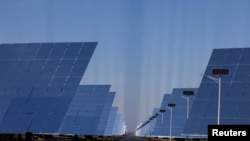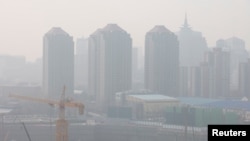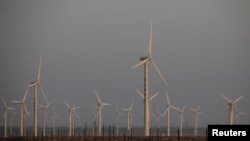China’s carbon emissions might peak before its target date of 2030 and its growing green economy could set an example for energy transition — even though the country relies heavily on coal and is currently the world’s biggest greenhouse gas emitter, experts say.
The country’s seemingly contradictory position in the fight against global warming comes into focus ahead of the 29th annual U.N Framework Convention on Climate Change conference, or COP 29, which begins November 11 in Baku, Azerbaijan.
The world’s second most populous nation emits the most greenhouse gases in the world, reaching 12.6 gigatons in 2023, according to the International Energy Agency.
But simultaneously, it contributed as much as 60% of the global increase in solar panels, wind power and electric vehicles.
Asked if China is the problem or the solution to climate change, Nithi Nesadurai, director and regional coordinator for climate advocacy group Climate Action Network Southeast Asia, said the country’s actions present both a challenge and an opportunity.
He said the current volume of emissions from China is a relatively recent development.
“Historically, the U.S. and EU have emitted substantially more greenhouse gases over a longer period, since the 1850s dating back to the Industrial Revolution, contributing disproportionately to the current climate crisis. When emissions are calculated on a per capita basis, China is about half of that in the U.S.,” he explained.
Emissions peaking
Fossil fuels still made up the majority of China’s energy mix last year, with about less than one-fourth of energy consumption coming from clean, renewable sources, government data showed. In its polluting power sector, its per capita emissions were more than double the global average, according to a report from the Britain-based energy research and policy organization Ember.
Currently, China’s goal is for emissions to peak in 2030 and reach net-zero in 2060. For the former, experts say, China is on a good track to peak earlier than 2030, if not already.
“China’s CO2 emissions have been falling since March this year and have continued to fall in the second and third quarters,” Lauri Myllyvirta, senior fellow at the Asia Society Policy Institute and lead analyst at the Centre for Research on Energy and Clean Air (CREA) told VOA News.
“There is a change in the trend after the sharp increase in 2021 to 2023,” he said. “If China keeps its clean energy additions of solar and wind at the levels that were reached last year … China’s emissions will enter a structural decline, which would mean that 2023 or early 2024 would mark the peak.”
This echoed the projection of Ryna Cui, associate research professor and acting director of the Center for Global Sustainability at the University of Maryland. Her studies indicate that China’s emissions will peak in 2025.
“This is mainly driven by the very fast development of green technologies, particularly solar and wind. We’re seeking EV deployment very fast. [It’s] also driven by declining demand for a lot of energy intensive products like construction materials because of economic slowdown and restructuring,” she said.
More coal-fired power plants
One of the main sources of China’s emissions is coal: the nation is the world’s largest producer, importer and consumer of coal, according to data from the IEA. In 2023, its coal production reached a record high.
This comes after Beijing approved permits for new coal-fired power plants capable of producing over 100 gigawatts in both 2022 and 2023, according to a report from CREA.
The drive for boosting coal use was to ensure “enough capacity in the grid to deal with increasing electric peak loads, rather than to increase the overall power generation from coal,” Myllyvirta said.
Both Myllyvirta and Cui say they expect the use of coal-fired plants, including those newly built, will go down gradually. “As China keeps building a large amount of wind and solar, we’ll see that trend more clearly,” said Cui.
Environmental group Greenpeace Asia is not so convinced. “A rebound remains possible until there are firm measures put in place to directly prevent further coal expansion,” the group said in a statement. “And without more proactive support for wind and solar grid connectivity, a post-peak plateau remains a risk."
China’s carbon emissions did not increase in Q3 2024 despite the rise of coal power, CREA’s latest report showed. The higher coal emissions were reportedly offset by a reduction in emissions caused by oil use and the production of steel and cement.
Renewable success
China has secured its position as the global leader in developing sources of renewable energy, with 180 gigawatts of solar and 159 gigawatts of wind power under construction, according to Global Energy Monitor. Combined, the capacity is close to double as the rest of the world together, enough to power the whole of South Korea.
In terms of electricity generation, wind and solar energy production hit a record high last year in China, accounting for 16% of all power generated, 3% higher than the global average, Ember’s report showed.
Beijing has pushed national policies for several years to boost the development of solar and wind capacity, including allocating deserts for building renewable energy parks, promoting rooftop solar panels and supporting offshore wind plants.
Such centralized public policies have driven capacity building and in turn, stimulated the green economy, Myllyvirta said.
“There’s a lot of enthusiasm from local governments, state banks, private investors for solar and wind projects, because they are profitable, especially after the real estate market contraction,” she said. “All of these players were looking for new targets for investment and sources of growth.”
Grid challenges
While both experts were confident that China will reach its 2030 target, they were hesitant to say the same for the 2060 net-zero goal. Connecting wind and solar energy to all of the nation’s power grids to replace fossil fuel generation could take a long time, Myllyvirta said.
“Integrating these very large amounts of new solar and wind into the power grid requires major changes to how the grid operates … this kind of reform has taken a very long time to implement in China. They are being pursued,” he explained.
Despite the challenges, at the upcoming COP29 in Baku, China will have a “major role to play” in climate negotiations as it can “enable tripling of renewable power generation globally” – a commitment countries agreed on at COP28 in Dubai last December, according to CAN’s Nesadurai.



